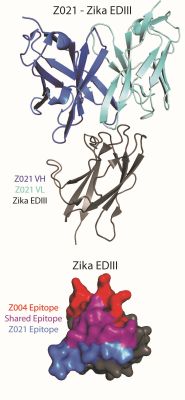 |
Figure: FAB Z021 bound to Zika envelope protein, EDIII (top); overlapping epitopes on Zika EDIII (bottom). |
Zika virus is a mosquito-borne flavivirus that usually causes mild symptoms in infected individuals, but can result in devastating neurological outcomes to babies born to women infected during pregnancy. Vaccine development for Zika and other flaviviruses is hindered by concerns of antibody-dependent enhancement (ADE), in which antibodies that bind but do not neutralize can enhance instead of prevent infection. To avoid concerns about ADE, passive transfer of potent antibodies may provide a safe and effective alternative to vaccination. Pamela Bjorkman and her group at Caltech determined the crystal structures of the potent human monoclonal antibody Z021 bound to its antigen in the Zika envelope protein (EDIIIZIKV) and in the dengue 1 envelope protein (EDIIIDENV1). The structures show that the Z021 antibody recognizes the two flaviviruses similarly, binding to the lateral ridge of the EDIIIs. Collaborators at Rockefeller University and the California National Primate Research Center at University of California, Davis showed that Z021, in combination with another potent human antibody, Z004, which recognizes a distinct but overlapping epitope, decreased viremia and prevented Zika viral escape in a non-human primate model. Although sterilizing protection was not reached in this high-dose challenge, the study aids our understanding of cross-reactivity of anti-flavivirus antibodies and of viral escape in the context of antibody pre-exposure prophylaxis.
Citation: Keeffe, JR, Van Rompay, KKA, Olsen, PC, Wang, Q, Gazumyan, A, Azzopardi, SA, Schaefer-Babajew, D, Lee, YE, Stuart, JB, Singapuri, A, Watanabe, J, Usachenko, J, Ardeshir, A, Saeed, M, Agudelo, M, Eisenreich, T, Bournazos, S, Oliveira, TY, Rice, CM, Coffey, LL, MacDonald, MR, Bjorkman, PM, Nussenzweig, MC, Robbiani, DF, A combination of two human monoclonal antibodies prevents Zika virus escape mutations in non-human primates, Cell Reports 25, 1385-1394 (2018). DOI: 10.1016/j.celrep.2018.10.031